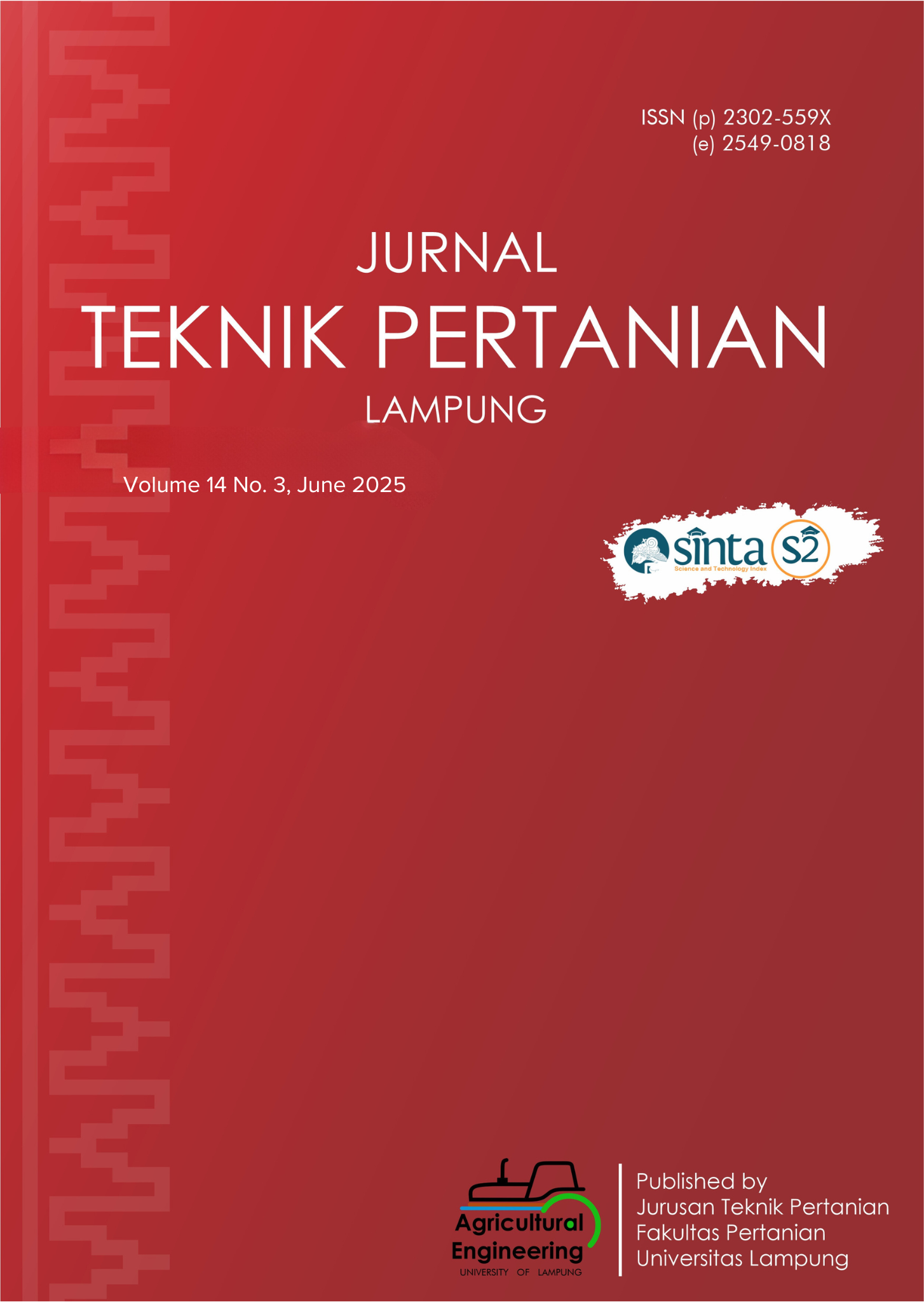Fulfillment of Distribution Permit Requirements for Yoghurt MSMEs
DOI:
https://doi.org/10.23960/jtep-l.v14i3.1012-1021 Abstract View: 80
Abstract View: 80
Abstract
Micro, small and medium enterprises (MSMEs) face challenges in obtaining distribution permits from the Indonesian Food and Drug Authority (BPOM) for food produced domestically, due to their limited knowledge and competence in implementing good manufacturing practices (GMP) and preparing the registration requirements. This study aimed to: (1) improve the achievement of GMP implementation in yoghurt MSMEs in preparation to get distribution permits; and (2) verify the fostering results of yoghurt MSMEs through microbiological testing. Field observations and interviews were conducted over the owner or manager of seven yoghurt MSMEs using assessment form, and mentoring program was developed to help the MSMEs fulfill permit requirements. Verification was done through microbiological testing. Results of the study showed that yogurt enterprises with ratings A, B, and C were found to have one MSME each (14.3%), while four MSMEs (57.1%) were at D ratings. The mentoring program for two MSMEs (A and B ratings) showed the decrease of unconformities and increase of MSME rating from B to A. The mentoring program has been successful in bringing the two MSMEs to fulfill all registration requirements for processed food distribution permit. The result of the Salmonella test on yoghurt samples was negative, and the presence of Enterobacteriaceae was within the permissible limits (<10 colonies/g).
Keywords: GMP, MSME, Processed food, Distribution permit, Yoghurt.
Downloads
References
Amin, M.Z., Nugroho, L.P.E., & Nurjanah. (2018). Kajian implementasi GMP dan SSOP ikan teri nasi setengah kering di Kabupaten Tuban. Jurnal Pengolahan Hasil Perikanan Indonesia, 21(3), 406–413.
Ardhanawinata, A., Irawan, I., Pagoray, H., Fitriyana, Pamungkas, B.F., & Zuraida, I. (2023). Penerapan SSOP (sanitation standard operating procedure) pada proses pembuatan amplang di BDS snack, Balikpapan, Kalimantan Timur. Media Teknologi Hasil Perikanan, 11(1), 18–24.
Asari, A., Zulkarnaini, Hartatik, Anam, A.C., Suparto, Litamahuputty, J.V., Dewadi, F.M., Prihastuty, D.R., Maswar, Syukrilla, W.A., Murni, N.S., & Sukwika, T. (2023). Pengantar Statistik. Padang: Mafy Media Literasi Indonesia.
Balai POM Bogor. (2023). Laporan Tahunan BPOM di Bogor Tahun 2023. Badan Pengawas Obat dan Makanan. Bogor.
BPOM (Badan Pengawas Obat dan Makanan). (2018). Peraturan Badan Pengawas Obat dan Makanan Nomor 30 Tahun 2018 tentang Angka Konsumsi Pangan. Badan Pengawas Obat dan Makanan. Jakarta.
BPOM (Badan Pengawas Obat dan Makanan). (2019). Peraturan Kepala Badan Pengawas Obat dan Makanan Nomor 13 Tahun 2019 tentang Batas Maksimal Cemaran Mikroba dalam Pangan Olahan. Badan Pengawas Obat dan Makanan. Jakarta.
BPOM (Badan Pengawas Obat dan Makanan). (2022a). Keputusan Kepala Badan POM NO.HK.02.02.1.2.01.22.63 Tahun 2022 tentang Pedoman Pemeriksaan Sarana Produksi Pangan Olahan. Badan Pengawas Obat dan Makanan. Jakarta.
BPOM (Badan Pengawas Obat dan Makanan). (2022b). Handbook Registrasi Pangan Olahan Yogurt, Yogurt Kultur Lain (Alternate Culture Yogurt), Yogurt Berperisa/Rasa, Kefir, Minuman Susu Fermentasi, Minuman Susu Fermentasi Berperisa/Rasa. Badan Pengawas Obat dan Makanan, Jakarta.
Donauer, M., Peças, P., & Azevedo, A. (2015). Identifying nonconformity root causes using applied knowledge discovery. Robotics and Computer-Integrated Manufacturing, 36, 84–92. https://doi.org/10.1016/j.rcim.2014.12.012
Ernawanti, E., Kusnandar, F., & Wulandari, N. (2018). Pemenuhan persyaratan label produk pangan yang dijual online terhadap peraturan label pangan. Jurnal Mutu Pangan, 5(1), 50–58.
Fernandez, M.A., Picard-Deland, E., Le Barz, M., Daniel, N., & Marette, A. (2017). Yogurt and health. In Fermented foods in health and disease prevention (pp. 305–338). Academic Press. https://doi.org/10.1016/B978-0-12-802309-9.00013-3
Fithriyani, D., Pangastuti, H.A., Wahyuningtyas A., Permana L., & Budiman A. (2022). Evaluasi pemenuhan elemen cara produksi pangan yang baik untuk industri rumah tangga (CPPB-IRT) pada UKM pempek. Carrade: Jurnal Pengabdian Kepada Masyarakat, 4(3), 385–392.
Irawan, A. (2019). Kalibrasi spektrofotometer sebagai penjaminan mutu hasil pengukuran dalam kegiatan penelitian dan pengujian. Indonesian Journal of Laboratory, 1(2), 1–9. https://doi.org/10.22146/ijl.v1i2.44750
ISO. (2017). ISO 6579-1:2017 Microbiology of the food chain - Horizontal method for the detection, enumeration and serotyping of Salmonella. International Standard Organizatio. Swiss.
Kemenkes (Kementerian Kesehatan). (2023). Peraturan Menteri Kesehatan Nomor 2 Tahun 2023 tentang Peraturan Pelaksanaan Peraturan Pemerintah Nomor 66 Tahun 2014 tentang Kesehatan Lingkungan. Kementerian Kesehatan. Jakarta.
Kemenperin (Kementerian Perindustrian). (2010). Peraturan Menteri Perindustrian Nomor 75/M-INDd/PER/7/2010 tentang Pedoman Cara Produksi Pangan Olahan yang Baik (Good Manufacturing Practices). Kementerian Perindustrian. Jakarta.
Nagaoka, S. (2019). Yogurt Production. Methods Mol Biol, 1887, 45–54. https://doi.org/10.1007/978-1-4939-8907-2_5
Negassa, B., Ashuro, Z., & Soboksa, N.E. (2022). Hygienic food handling practices and associated factors among food handlers in Ethiopia: A systematic review and meta-analysis. Environmental Health Insights, 16, 1–9. https://doi.org/10.1177/11786302221105320
Pemerintah Republik Indonesia. (2021). Peraturan Pemerintah Nomor 7 Tahun 2021 tentang Kemudahan, Pelindungan dan Pemberdayaan Koperasi dan Usaha Mikro, Kecil dan Menengah. Peraturan Pemerintah. Jakarta.
Rebouças, L.T., Santiago, L.B., Martins, L.S., Menezes, A.C.R., Araújo, M.P.N., & Almeida, R.C.C. (2017). Food safety knowledge and practices of food handlers, head chefs and managers in hotels' restaurants of Salvador, Brazil. Food Control, 73, 372–381. https://doi.org/10.1016/j.foodcont.2016.08.026
Riyanti, R., Putri, D.H., Erlinda, & Yuniarti, E. (2021). Deteksi bakteri E.coli dan Coliform dengan metode CFU pada uji kualitas air bersih. Prosiding Seminar Nasional Biologi Universitas Negeri Padang, 1(2), 925-934.
Satria, R.G., Hamid, I.S., Wibawati, P.A., Estoepangestie, A.T.S., Saputro, A.L., & Praja, R.N. (2021). Identifikasi Salmonella sp. pada susu segar di peternakan sapi perah Kecamatan Licin Kabupaten Banyuwangi. Media Kedokteran Hewan, 32(3), 114–118. https://doi.org/10.20473/mkh.v32i3.2021.114-118
Sucipto, S., Sumbayak, P.W., & Perdani, C.G. (2020). Evaluation of good manufacturing practices (GMP) and sanitation standard operating procedure (SSOP) implementation for supporting sustainable production in bakery SMEs. Turkish Journal of Agriculture -Food Science and Technology, 8(1), 7–12. https://doi.org/10.24925/turjaf.v8i1.7-12.1960
Tsai, K., Hoffmann, V., Simiyu, S., Cumming, O., Borsay, G., & Baker, K.K. (2022). Bacteroides microbial source tracking markers perform poorly in predicting Enterobacteriaceae and enteric pathogen contamination of cow milk products and milk-containing infant food. Front Microbiol, 12, 778921. https://doi.org/10.3389/fmicb.2021.778921
Widyanti, T., & Fatmawati, A. (2022). Deteksi kelompok Enterobacteriaceae pada tanah di lingkungan tempat pembuangan akhir sampah tamangapa Kecamatan Manggala Makassar. Jurnal Ilmu Alam dan Lingkungan, 13(1), 23–31.
Yahya, H., Samicho, Z., Firdaus, A., & Azmi, M.N. (2016). A review on application of halalan-toyyiban risk management plan (HTRMP) and frozen food chain during warehousing activities for maintaining halal, safety, and quality. Journal of Applied Enviromental and Biological Sciences, 6(11), 96–102.
Yang, S.Y., &Yoon, K.S. (2022). Effect of probiotic lactic acid bacteria (LAB) on the quality and safety of greek yogurt. Foods, 11(23), 3799. https://doi.org/10.3390/foods11233799
Zastempowska, E., Grajewski, J., & Twarużek, M. (2016). Food-borne pathogens and contaminants in raw milk a review. Annals of Animals Science, 16(3), 623–639. https://doi.org/10.1515/aoas-2015-0089
Downloads
Published
How to Cite
Issue
Section
License
Authors who publish with this journal agree to the following terms:
Authors retain copyright and grant the journal right of first publication with the work simultaneously licensed under a Creative Commons Attribution-ShareAlike 4.0 International Lice that allows others to share the work with an acknowledgement of the work's authorship and initial publication in this journal.
Authors are able to enter into separate, additional contractual arrangements for the non-exclusive distribution of the journal's published version of the work (e.g., post it to an institutional repository or publish it in a book), with an acknowledgement of its initial publication in this journal.
Authors are permitted and encouraged to post their work online (e.g., in institutional repositories or on their website) prior to and during the submission process, as it can lead to productive exchanges, as well as earlier and greater citation of published work (See The Effect of Open Access).
Jurnal Teknik Pertanian Lampung

JTEPL is licensed under a Creative Commons Attribution-ShareAlike 4.0 International License.













